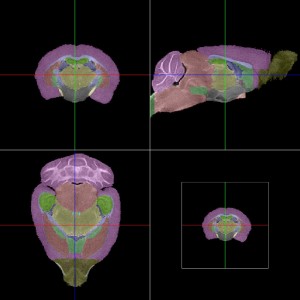By accessing this data, you agree to the terms of the MouseBIRN Data Use Agreement.
An atlas based on a magnetic resonance microscopy (MRM) image diffusion-weighted in the Z-direction acquired from a normal, 100-day old male C57BL/6J mouse. The atlas is comprised of a diffusion-weighted image volume, a label volume, a mask volume, and a label index.
Note: A download for this dataset will be available soon.
Description
MRM. Mice were anesthetized initially with ketamine/xylzaine and then maintained on isofluorane for the duration of the imaging experiment. Magnetic resonance imaging was done at 37 C using an 89 mm vertical bore 11.7 T Bruker Avance imaging spectrometer with a micro-imaging gradient insert and 30 mm birdcage RF coil (Bruker Instruments). Typical imaging parameters were as follows: T2-weighted RARE 3D imaging protocol (8 echoes), matrix dimensions = 256 x 256 x 256; FOV = 3 cm x 1.5 cm x 1.5; repetition time (TR) = 1500 ms; effective time (TE) = 10 ms; number of averages = 4. The images were padded with zeros to double the number of time domain points in each dimension, the Fourier transformed to yield a matrix of 512 x 256 x 256. This procedure is commonly called zero-filling and is a well known interpolation method (Farrar and Becker, 1971; Fukushima and Roeder, 1981). Typical spatial resolution was approximately 60 um3 per voxel.
Nomenclature and Delineations. Neural structures (including cell groups, fiber tracts and gross anatomical features such as the ventricles) were determined under the microscope from the histologically stained sections. 3D label volumes were painted onto coregistered MRM, Nissl-, myelin-, and acetylcholine esterase-stained volumes using BrainSuite (Shattuck and Leahy, 2002). The delineations depict asymmetries present in the sections, making them more immediately useful than if they were stylized. Delineation of brain nuclei requires an expert neuroanatomist to draw on high-level knowledge, accumulated over a lifetime of careful study of disparate materials (Swanson, 1998). Consequently, manual input was necessary for even approximate parcellation of brain in its fine details. In the development of a comprehensive, standardized, and mutually exclusive nomenclature (Bowden and Martin, 1995; Bard et al., 1998) and anatomic delineation, our primary reference was the mouse brain atlas of Paxinos and Franklin (Paxinos and Franklin, 2001).
Usage
This atlas volume can be viewed using the Mouse BIRN Atlasing Tool (MBAT) or SHIVA. See the respective manuals for these programs.
Accession Number
TBD
Download
http://www.loni.ucla.edu/Atlases/Atlas_Detail.jsp?atlas_id=19
Contributors/Authors
Allan MacKenzie-Graham1, Erh-Fang Lee1, Ivo D. Dinov1, Mihail Bota2, David W. Shattuck1, Seth Ruffins3, Heng Yuan1, Fotios Konstantinidis1, Alain Pitiot1,4, Yi Ding1, Guogang Hu1, Russell E. Jacobs3, and Arthur W. Toga1
- Laboratory of Neuro Imaging, Department of Neurology, University of California, Los Angeles, 710 Westwood Plaza, Room 4-238, Los Angeles, California 90095-1769, USA
- NIBS – Neuroscience Program, University of Southern California, Los Angeles, California 90089-2520, USA
- Beckman Institute, California Institute of Technology, 1200 E. California Blvd., Pasadena, California 91125-7400, USA
- EPIDAURE Laboratory, Institut National de Recherche en Informatique et en Automatique, Sophia Antipolis 06902, France
Technical Contacts
Allan MacKenzie-Graham (amg *AT* ucla.edu)
Acknowledgements
This work was generously supported by research grants from the National Institute of Mental Health (5 RO1 MH61223) and the National Institutes of Health/National Center for Research Resources (P41 RR13642).



